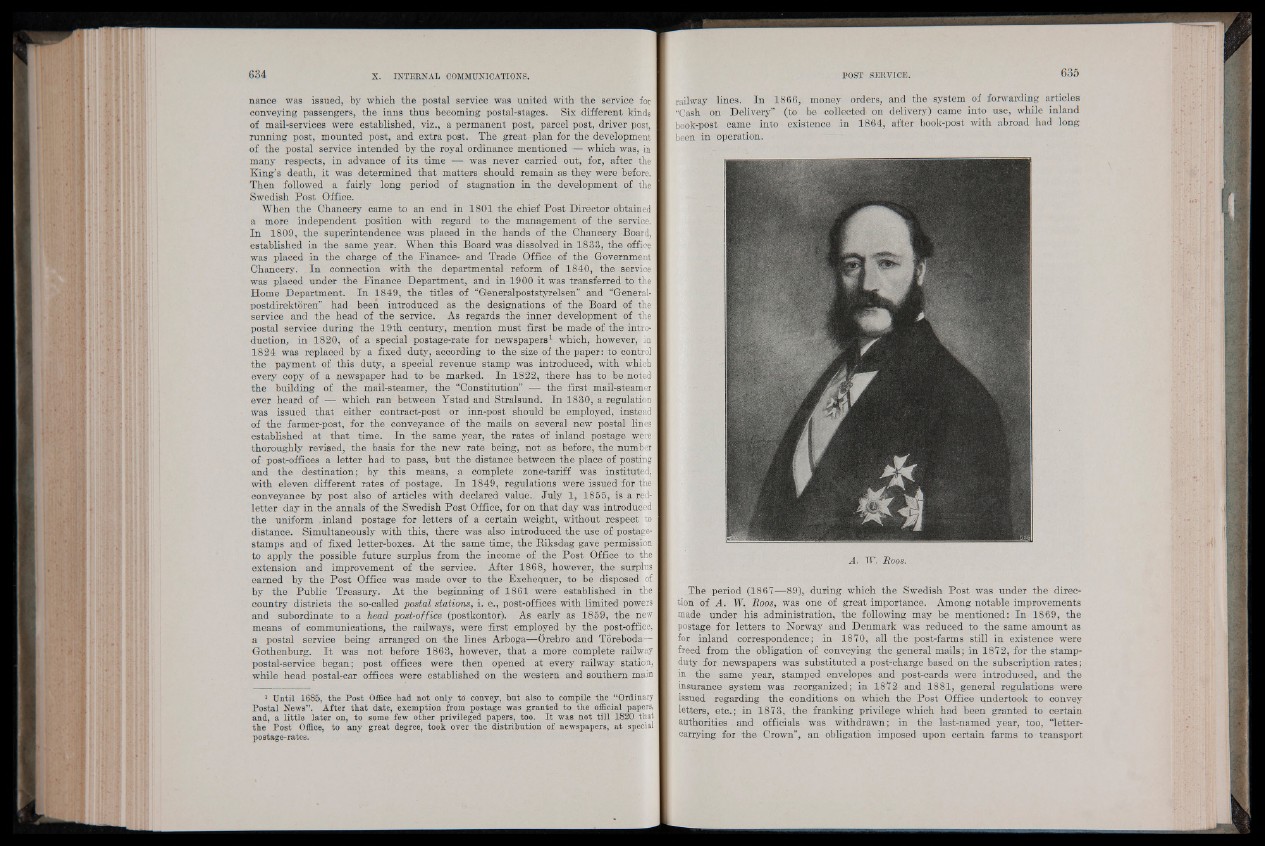
nance was issued, by which the postal service was united with the service for
conveying passengers, the inns thus becoming postal-stages. Six different kinds
of mail-services were established, viz., a permanent post, parcel post, driver post,
running post, mounted post, and extra post. The great plan for the development
of the postal service intended by the royal ordinance mentioned which was, in
many respects, in advance of its time — was never carried out, for, after the
Bang’s death, it was determined that matters should remain as they were before.
Then followed a fairly long period of stagnation in the development of the
Swedish Post Office.
When the Chancery came to an end in 1801 the chief Post Director obtained
a more independent position with regard to the management of the service.
In 1809, the superintendence was placed in the hands of the Chancery Board,
established in the same year. When this Board was dissolved in 1833, the office
was placed in the charge of the Finance- and Trade Office of the Government
Chancery. In connection with the departmental reform of 1840, the service
was placed under the Finance Department, and in 1900 it was transferred to the
Home Department. In 1849, the titles of “Generalpoststyrelsen” and “General-
postdirektoreft” had been introduced as the designations of the Board of the
service and the head of the service. As regards the inner development of the
postal service during the 19th century, mention must first be made of the introduction,
in 1820, of a special postage-rate for newspapers1 which, however, in
1824 was replaced by a fixed duty, according to the size of the paper: to control
the payment of this duty, a special revenue stamp was introduced, with which
every copy of a newspaper had to be marked. In 1822, there has to be noted
the building of the mail-steamer, the “Constitution”. — the first mail-steamer
ever heard of — which ran between Ystad and Stralsund. In 1830, a regulation
was issued that either contract-post or inn-post should be employed, instead
of the farmer-post, for the conveyance of the mails on several new postal lines
established at tha t time. In the same year, the rates of inland postage were
thoroughly revised, the basis for the new rate being, not as before, the number
of post-offices a letter had to pass, but the distance between the place of posting
and the destination;, by this means, a complete zone-tariff was instituted,
with eleven different rates of postage. In 1849, regulations were issued for the
conveyance by post also of articles with declared value.. July 1, 1855, is a red-
letter day in the annals of the Swedish Post Office, for on that day was introduced
the uniform , inland postage for letters of a certain weight, without respect; to
distance. Simultaneously with this, there was also introduced the use of postage-
stamps and of fixed letter-boxes. At the same time, the Riksdag gave permission
to apply the possible future surplus from the income of the Post Office to the
extension and improvement of the service. After 1868, however, the surplus
earned by the Post Office was made over to the Exchequer, to be disposed of
by the Public Treasury. At the beginning of 1861 were established in the
country districts the so-called postal stations, i. e., post-offices with limited powers
and subordinate to a head post-office (postkontor). As early as 1859, the new
means of communications, the railways, were first employed by the post-office,
a postal service being arranged on the lines Arboga—Örebro and Toreboda—
Gothenburg. I t was not before 1863, however, that a more complete railway
postal-service began; post offices were then opened at every railway station,
while head postal-car offices were established on the western and southern main
1 Until 1685, the Post Office had not only td convey, bnt also to compile the “Ordinary
Postal News”. After that date, exemption from postage was granted to the official papers,
and, a little later on, to some few other privileged papers, too. It was not till 1820 that
the Post Office, to any great degree, took over the distribution of newspapers, at special
postage-rates.
railway lines. In 1866, money orders, and the system of forwarding articles
“Cash on Delivery” (to be collected on delivery) came into use, while inland
book-post came into existence in 1864, after book-post with abroad had long
been in operation.
A. W. Boos.
The period (1867—89), during which the Swedish Post was under the direction
of A. W. Boos, was one of great importance. Among notable improvements
made under his administration, the following may be mentioned: In 1869, the
postage for letters to Norway • and Denmark was reduced to the same amount as
for inland correspondence; in 1870, all the post-farms still in existence were
freed from the obligation of conveying the general mails; in 1872, for the stamp-
duty for newspapers was substituted a post-charge based on the subscription ra te s;
in the same year, stamped envelopes and post-cards were introduced, and the
insurance system was reorganized; in 1872 and 1881, general regulations were
issued regarding the conditions on which the Post Office undertook to convey
letters, etc.; in 1873, the franking privilege which had been granted to certain
authorities and officials was withdrawn; in the last-named year, too, “letter-
carrying for the Crown”, an obligation imposed upon certain farms to transport